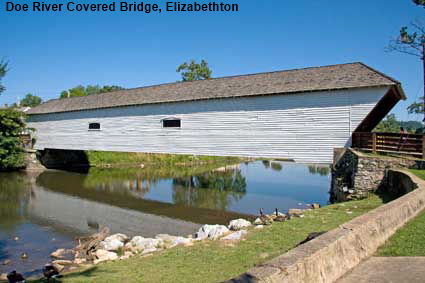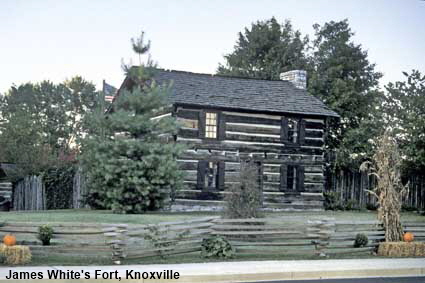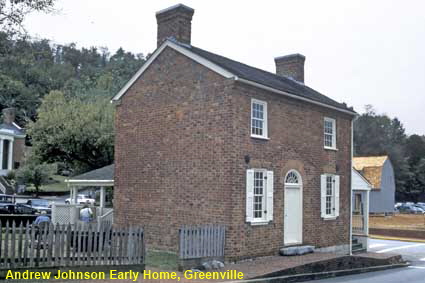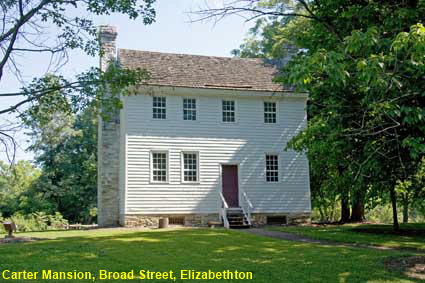In the early days of European settlement the Appalachian Mountains were a natural barrier, dividing the British settlements near the east coast from French settlement up the Mississippi. After Britain won the French and Indian War in 1763, British settlers began to cross the Appalachians to extend North Carolina westwards, settling in the area that is now North East Tennessee. After the Revolutionary War North Carolina showed little interest in the distant settlements west of the Appalachians, so in 1784 the breakaway state of Franklin was founded. It was disbanded in 1787 when given the right to send representatives to the North Carolina legislature but only 2 years later the land was ceded to form the Southwest Territory. The early settlement of this area has left it with a wealth of old buildings.
Doe River Covered Bridge, Elizabethton
Tennessee once had many covered bridges but only four now remain. One surviving covered bridge stands in the middle of Elizabethton. This Howe Truss bridge was built in 1882 and has a span of 41 metres (134 feet). The Howe Truss has timber diagonals with iron vertical members. The strength of this bridge was demonstrated in 1901 when a major flood washed away many other covered bridges in the area but this bridge withstood the flood despite logs and a barn being thrown against it. The Doe River Covered Bridge is closed to traffic but is still open for pedestrian traffic. Click Tab 2 to see a diagram of a Howe Truss.
North East Tennessee
Click on Minimap to navigate
Carter Mansion, Broad Street, Elizabethton
The Carter Mansion was built between 1775 and 1780 on land bought from the Cherokee Indians by Colonel John Carter, an early member of the Watauga Settlement. His son General Landon Carter inherited the house in 1781. Carter County was named after Landon Carter and the county town Elizabethton after his wife Elizabeth. The Carter Mansion is the oldest frame house in Tennessee and has retained much of its original finely detailed interior. Mansion might seem an overstatement for this house but it was a mansion but compared to others in the area at that time and it was the first house to have glass windows. The mansion is open to the public Wednesday to Sunday from mid May to mid August. Unfortunately it was closed when we visited.
James White's Fort, Knoxville
James White arrived in the early 1780s and he soon befriended the Cherokee Indians, trading with them and negotiating on their behalf treaties with other settlers. In 1786 he built a 2 storey log house. In 1791 White founded a town on his land and William Blount the governor of the Southwest Territory moved the territorial capital there. White named the town Knoxville in honour of Henry Knox, an American Revolutionary War general. White moved to another house in 1793 and there he died in 1821. In the 1830s a house was built alongside and the log house became its kitchen. When in 1906 the house was demolished, the log house was moved to Woodlawn Park. In 1968 the original timbers were used to rebuild James White’s Fort close to its original location. It is open to the public.


Chester Inn, Jonesborough
Jonesborough has retained many of its old buildings and the Jonesborough Historic District is listed on the National Register of Historic Places. The oldest wooden frame building in the commercial district is the Chester Inn. This Federal style inn was built in 1797 by Dr. William P. Chester from York County Pennsylvania. As a physician in a small frontier town, he needed the inn to supplement his income. It was the best hotel in the Tennessee frontier area and it also housed Dr Chester’s apothecary shop in the cellar. The front porch was added in 1880. The Inn is now owned by the Tennessee Historical Commission and is home to the International Storytelling Center
Andrew Johnson Early Home, Greenville
The 1865 assassination of Abraham Lincoln resulted in Vice President Andrew Johnson becoming the 17th President of the USA. Johnson was born in Raleigh (North Carolina) in 1808. His father in died in 1812 leaving his family in poverty. In 1824 he and his brother William ran away from tailoring apprenticeships to Greenville, Tennessee. Andrew started a tailoring business there in 1826, in 1827 he married, in 1829 he became a town alderman and then mayor. Later he represented Tennessee in both the House of Representatives and the Senate. He continued to attend the Senate during the Civil War despite the secession of Tennessee. In Greenville both his early home and his later homestead are open to the public as part of Andrew Johnson National Historic Site. Click Tab 2 to see the Homestead.


Old Deery Inn, Blountville
Another town in this area that has plenty of old buildings is Blountville. The town was established in 1792 on land donated by James Brigham for the site of the Sullivan county seat. The Old Deery Inn is one of numerous old buildings in the town listed on the National Register of Historic Places. This two storey Dutch clapboard structure was built as a main way-station on the Great Stage Road, but the date of construction is unknown. It was acquired by William Deery from Ulster in Ireland in 1801 and he developed the inn into a major trading post. Deery died in 1845 and the inn was leased to Gideon and Mary Cox Cates. The Civil War Battle of Blountville saw the town damaged by shelling, but not the inn as Gideon had bribed both sides not to shell it.


Jonesborough
Jonsborough was founded in 1779 during the Revolutionary War. It was named after Willie Jones, a North Carolina legislator who supported westward expansion of the state. After the Revolutionary War had been won local people felt that North Carolina had lost interest in its lands west of the Appalachians, and Jonesborough was the centre of attempts to set up the State of Franklin. Named after Benjamin Franklin, the state was formed in Jonesborough in 1784, and it was for a short time its capital before it moved to Greeneville. The US Congress did not recognise Franklin as a state, but continued to consider the area to be part of North Carolina. In 1787 the attempt to set up the State of Franklin was abandoned..

DLU110614


To move forwards or backwards through the Tennessee trail click the arrows above, or select your next destination on the Minimap.


© Mike Elsden 1981 - 2025
The contents of this page may not be reproduced in full or in part without permission